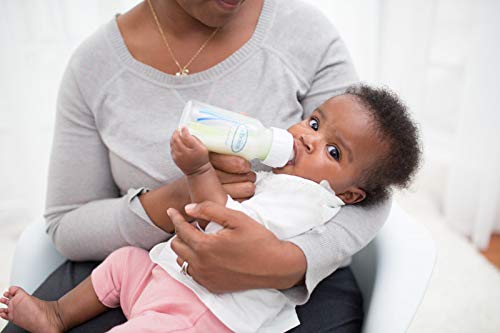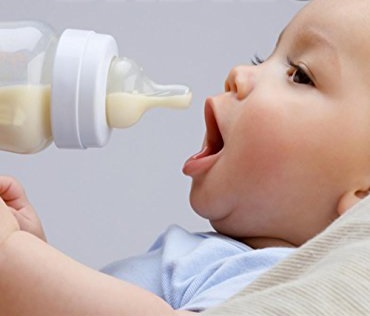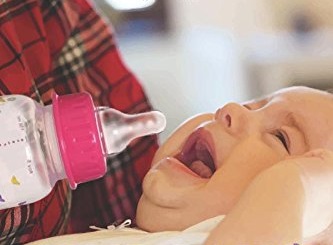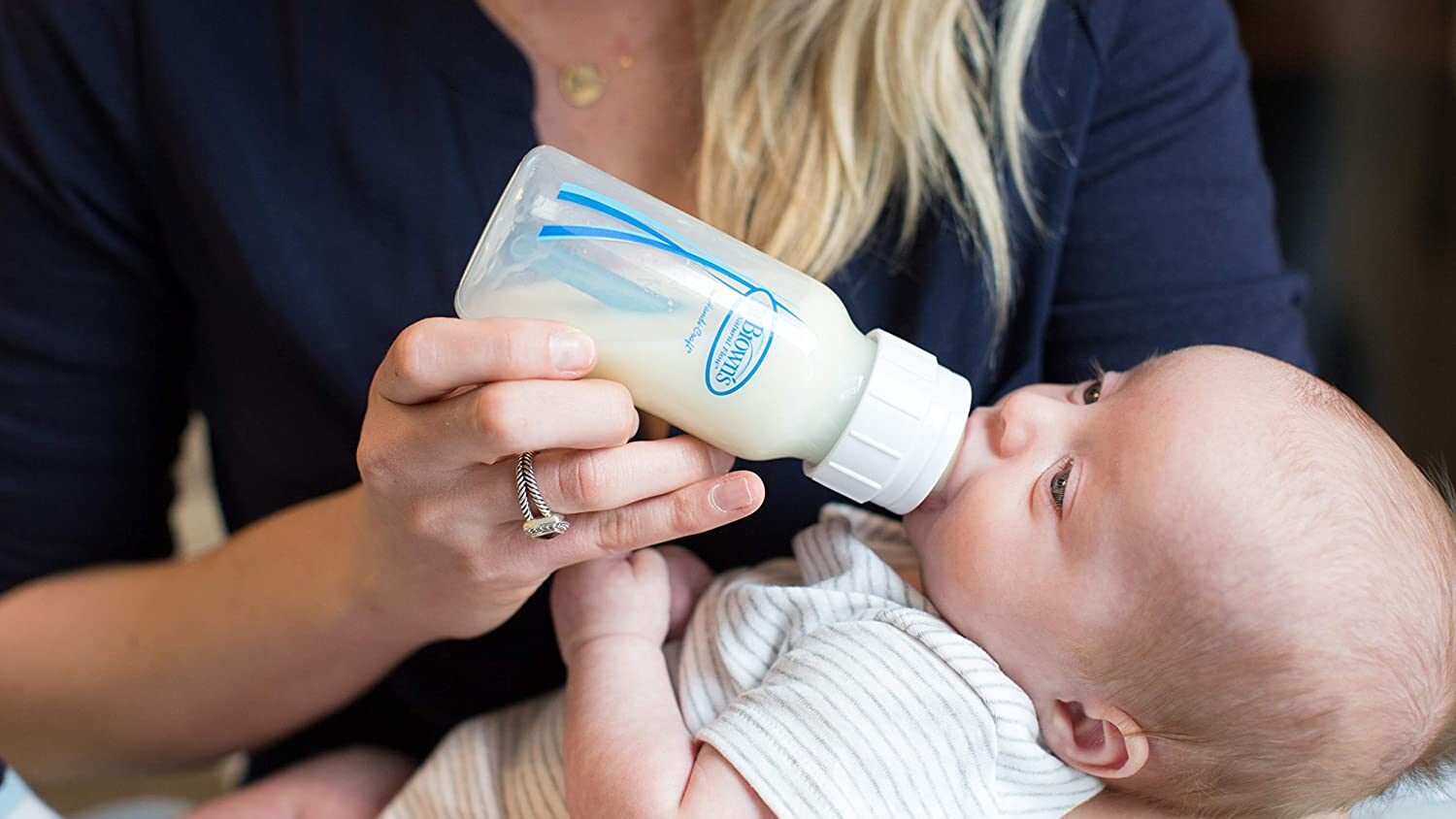A crying and fussy baby after feeding is not uncommon at all, especially for newborns. It can be stressful for new parents that are still trying to learn how to properly feed their little ones. Some new breastfeeding moms switch to bottle-feeding due to this, thinking that they do not have enough breast milk, or that it is easier to soothe a crying baby using a bottle. However, bottle-feeding comes with its fair share of feeding problems, and one of the bottle-feeding problems is a well-fed yet fussy baby.
Bottle Feeding Your Baby
Bottle feeding is a commonly used alternative to breastfeeding. Feeding your little one through a bottle does not necessarily mean feeding them with formula or cow’s milk. Some mothers create a breastmilk stash for their breastfed baby, putting their pumped breastmilk in the fridge, and reheating it in the baby’s bottle for feeding time. Some opt for formula to bottle-feed their babies.
Whatever kind of milk you choose – mother’s milk or formula – bottle-fed babies have the same problems. In this article, we will guide you through bottle feeding problems that may be disrupting you and your baby’s much needed sleep.
Top 10 Bottle-Feeding Problems

It is normal for a baby to cry. Oftentimes, your baby can be soothed by simply attending to their needs. Babies often cry due to hunger and it can be frustrating to still hear your baby cry even after feeding.
One of the signs of feeding problems is a crying baby, and there are a multitude of reasons as to why your baby might still be crying even after bottle feeding. Let’s explore some of the common reasons and signs one by one.
Colic
When a bottle-fed baby is fussy even after feeding, one of the go-to reasons every parenting support group may give is colic. This is a technical term given to instances where a baby cries for at least three hours a day, or three or more days a week, and your doctor or pediatrician can’t figure out why. Most babies experiencing colic are in the age bracket of zero to three months old.
Although there is not a specific set of reasons to explain why a baby experiences colic, this problem is often linked with gas or air that babies swallow when they drink through a bottle. For this reason, there are baby bottles on the market specifically designed with anti-colic features to prevent this from happening.
Your baby wants to breastfeed
Many breastfed babies may be nipple-confused, especially during the breast-to-bottle transition which is common among working moms. There may be times where you add the familiar breast milk to the bottle, but your breastfed little one will still refuse to feed.
There are multiple reasons why your little one prefers the mother’s nipple as compared to the nipple on the baby bottle.

For one, a breastfed baby may find the nipple of the mother easier to suck when feeding compared with the nipple on their baby bottle, as they are softer which presses easily on the baby’s gums. You may need to change your bottle’s nipple to a softer one as a solution.
As well as the texture, the size of the nipple on your bottle may not be quite right. Sometimes, a baby bottle’s nipple is larger or smaller compared to the familiar mother’s nipple, making it feel strange for your baby when you put the nipple in the baby’s mouth. You may want to check the size of the nipple on the bottle. If your baby has a very small mouth, sucking on a large bottle nipple might be too difficult for your baby during feedings.
Formula flow is either too slow or too fast
Whether your child is drinking formula or breastmilk, a too-fast or too-slow flow pace might put your baby off their drink. Feeding on milk with a fast flow is uncomfortable for your baby, causing them to cry in discomfort or stop drinking altogether. On the other hand, a slow flow can be bothersome for your baby, especially when they are very hungry and eager to be fed.
One of the solutions to this problem is changing the nipple of the baby bottle if necessary. If the top of the bottle is broken where the milk goes through, it may cause an undesirable flow. Often it is best to purchase a new nipple and see whether your child’s crying changes for the better.
Formula needs changing
One of the simplest solutions, when your baby seems uncomfortable during feeding, is to change formulas. The many formula brands and types can vastly differ from each other content-wise. Some are hypoallergenic for babies with sensitive tummies, and others are made a little bit sweeter than the others for babies who are sensitive to taste. Swapping formulas, similar to trying a different menu when you are eating, can help your baby identify which one suits their tastebuds or stomach more.
Your baby is still hungry

When your baby sucks on anything, take it as a sign that your baby needs to feed. A hungry baby will suck on whatever they can put their mouth on to mimic sucking a nipple. Babies who grew up breast feeding will immediately search for their mother’s breast.
Whether your baby is breastfeeding or bottle feeding, two of the early cues that your baby is hungry is a thumb or hand sucking and reaching for the mother’s breast.
Oftentimes, when your baby is still hungry even after feeding, your baby may still be showing these early cues. The best thing to do in that case is attempt to feed your baby more and see whether they will continue drinking.
Your baby is full
Although one of the solutions to soothing a baby who is distressed even after feedings is offering more, it is against medical advice to overfeed your baby as it can cause discomfort from incomplete digestion. Oftentimes, parents bottle feed their babies too early, or schedule feeding times too close together. Their babies start refusing the bottle in the middle of feeding as a result. Ideally, your baby should be feeding every three to four hours when formula-fed according to the CDC.
Formula temperature is either too hot or cold
When feeding your baby, breastmilk and formula are each served differently in terms of temperature and preparation. Breastmilk is often frozen and reheated when preparing to feed the baby. As parents, you need to make sure to test whether the temperature is drinkable, or else your baby could refuse to drink and will start crying – especially when your baby is already hungry.
This also applies to powdered formulas that are mixed with hot water. One parenting tip often given is to use room temperature water when making formula and just submerge the bottle in warm water to achieve the drinkable warm formula for your baby. If your baby is already used to warm milk, make sure to adjust the temperature and make it drinkable.
Acid reflux
When your child cries or is refusing to drink when you are trying to feed your baby, acid reflux or gastroesophageal reflux disease (GERD) could be causing the problem. This can be hard to pinpoint, as the symptoms mirror those of colic – spitting up and excessive crying. But if you find the problem is worse after feeding time, and especially if baby is lying down, then your baby may have acid reflux.

While it is tempting to search on the internet for solutions, acid reflux is one of those distressing conditions (both for the baby and their parents) that is best addressed medically as soon as possible. The best way to diagnose and treat acid reflux is to schedule a visit with your pediatric gastroenterologist.
Intolerance or allergy
In rare instances, breastfed babies may have allergies to some contents in their mother’s milk or formula. The common culprits are cow’s milk protein, egg, corn, and soy. Babies with milk intolerance, sensitivities, or allergies could show specific symptoms including bloody stools, but sometimes being uncomfortable after bottle feeding is the only symptom you will see.
There is not one single best way to figure out what your baby is allergic to, but by significantly changing your diet using some methods such as the elimination diet, your baby’s symptoms might be relieved. This method may also be helpful for babies with colic. For formula-fed babies, your doctor can help recommend a formula that is less likely to trigger an allergy or intolerance in your baby.
Gas and feeding position
In general, breastfed babies swallow less air compared to bottle-fed babies due to the way they eat. Sucking during breastfeeding allows less air into your baby’s belly than during a bottle feed. Either way, when your baby gets gas or gas buildup from bottle feeding, you can expect some crying after every feeding time as this can be very uncomfortable. One way to relieve your baby’s symptoms is by keeping your baby in an upright position after feeding, and giving your baby support in helping them burp.
Advice and Tips When Using a Bottle to Feed Your Baby

When bottle feeding your baby, always check the following.
Temperature
Is the temperature drinkable? Be sure to make it warmer or colder depending on your baby’s preference.
Comfortable
Is your baby in a comfortable position? Your baby may prefer another position during feeding time. Changing positions may improve your baby’s mood. Changing position can also help your baby burp easily.
Flow
Is the flow of the milk okay? Check the nipples to make sure they are not torn, and that they have enough opening for milk to flow when you bottle feed.
Breast or bottle?
Does your baby want breast milk or formula? Some babies prefer breast milk over formula and vis versa. Make sure to train your baby to take formula when transitioning.
Something else entirely?
Is your baby feeling well? Once you’ve checked all other reasons and you still have not figured out why your baby is crying, colic may be a likely reason. Otherwise, you can check other causes such as food allergies, fever, cough, and colds which may also contribute to a crying baby.
Other Ways to Soothe Your Baby
If the tips and advice mentioned above do not work to soothe your baby, you can try out these tips.
Diaper change
Change your baby’s diaper. Wet diapers can be uncomfortable, and this ruins the mood of your baby.
Rocking
Do a quick dance or song. Babies love constant movements like rocking, and it may help to play some music they can focus their attention on.
Skin-to-skin
Hold your baby close to your body. Skin-to-skin contact can be comforting for them, and the warmth of a mother or father can calm down a baby. After all, your baby does not want anyone else but you.
Bottom Line
Choosing whether to breastfeed or bottle feed a baby is one of the trickiest parenting choices, especially as there is so much conflicting advice out there. Breastfeeding can be difficult, but bottle feeding isn’t always a walk in the park, either!
Problems with bottle feeding aren’t uncommon, so it is good to make sure to know what you can do when these problems occur. Refer to the advice above when you’re in a tricky situation: sometimes it’s as simple as a change of formula.

